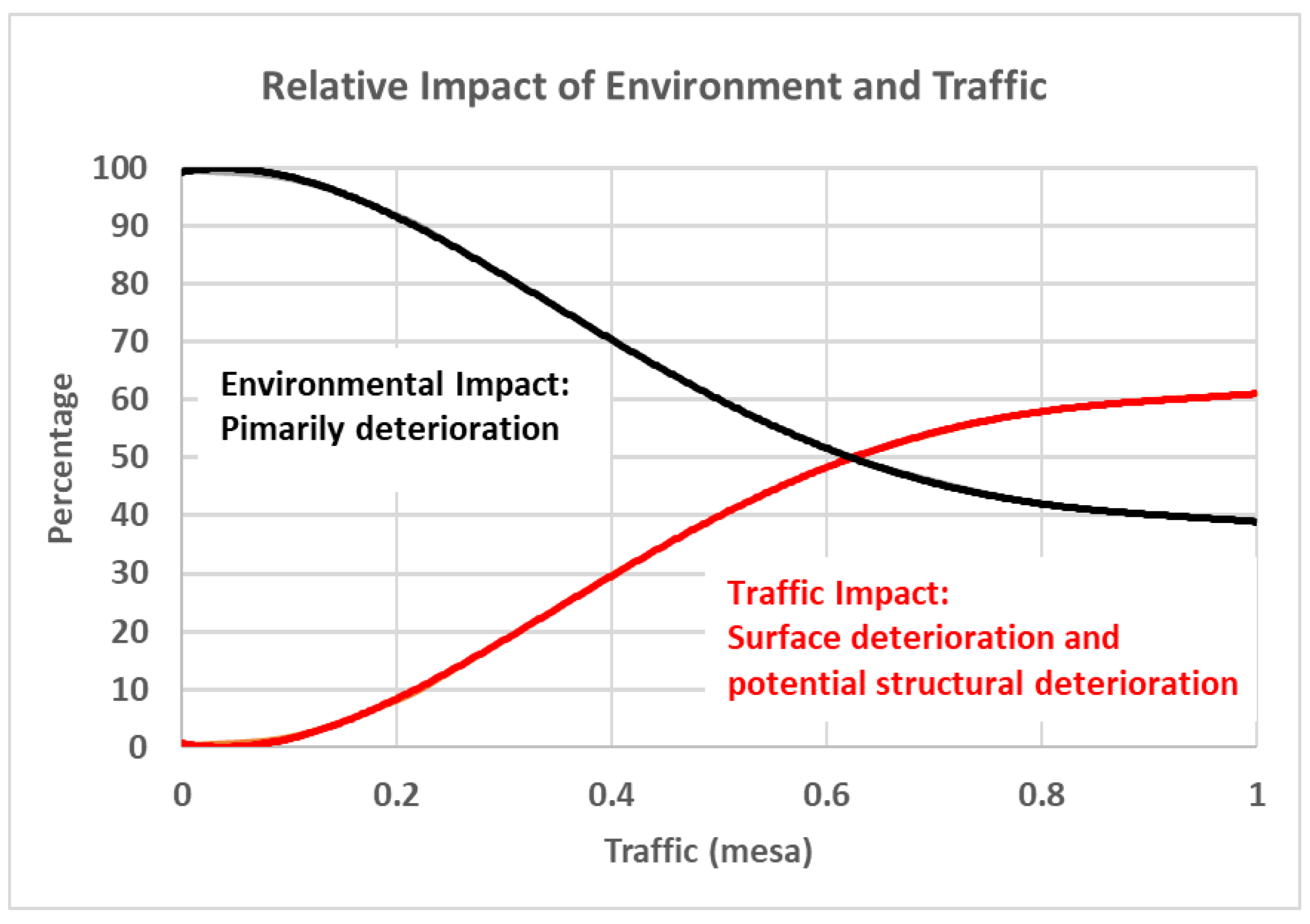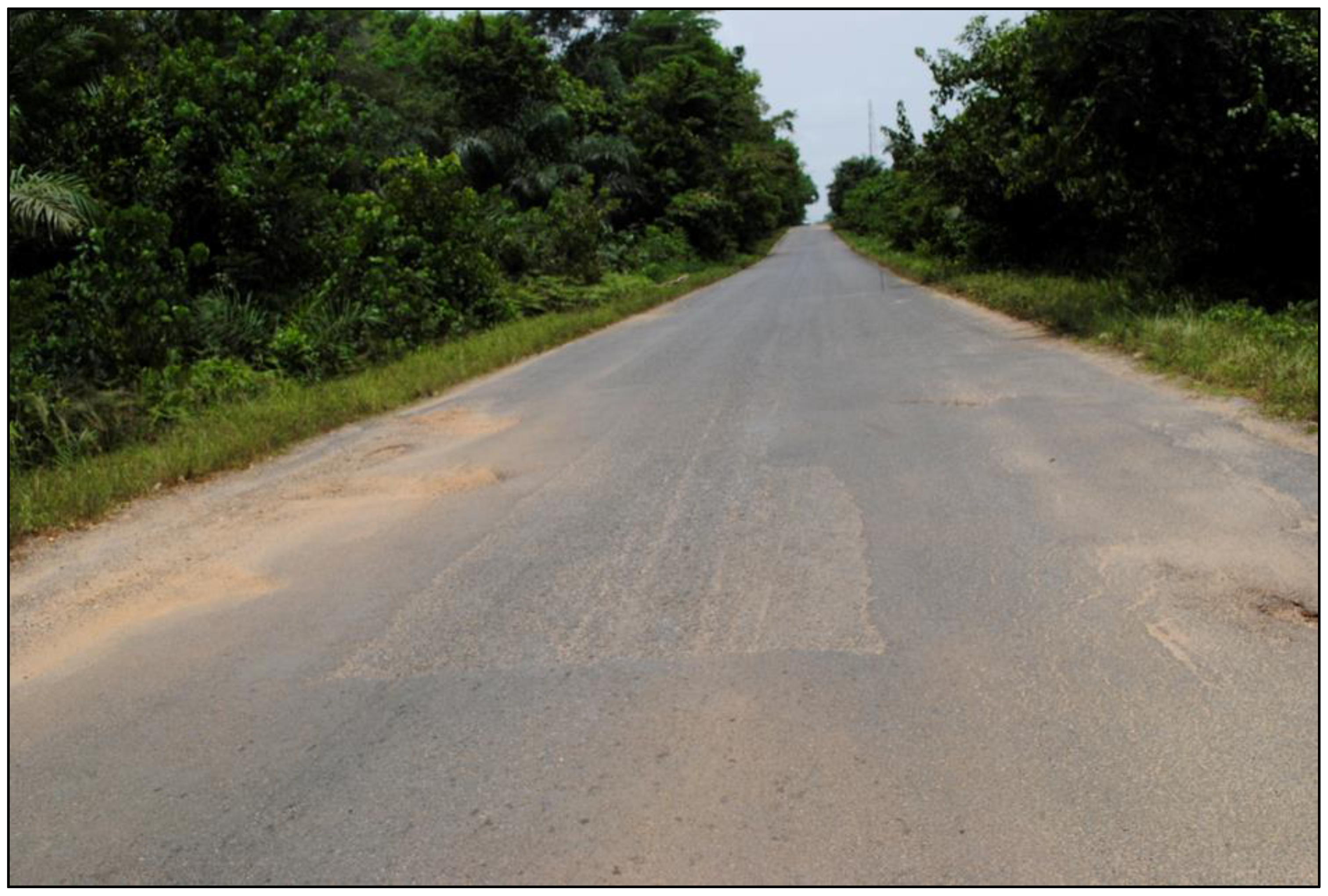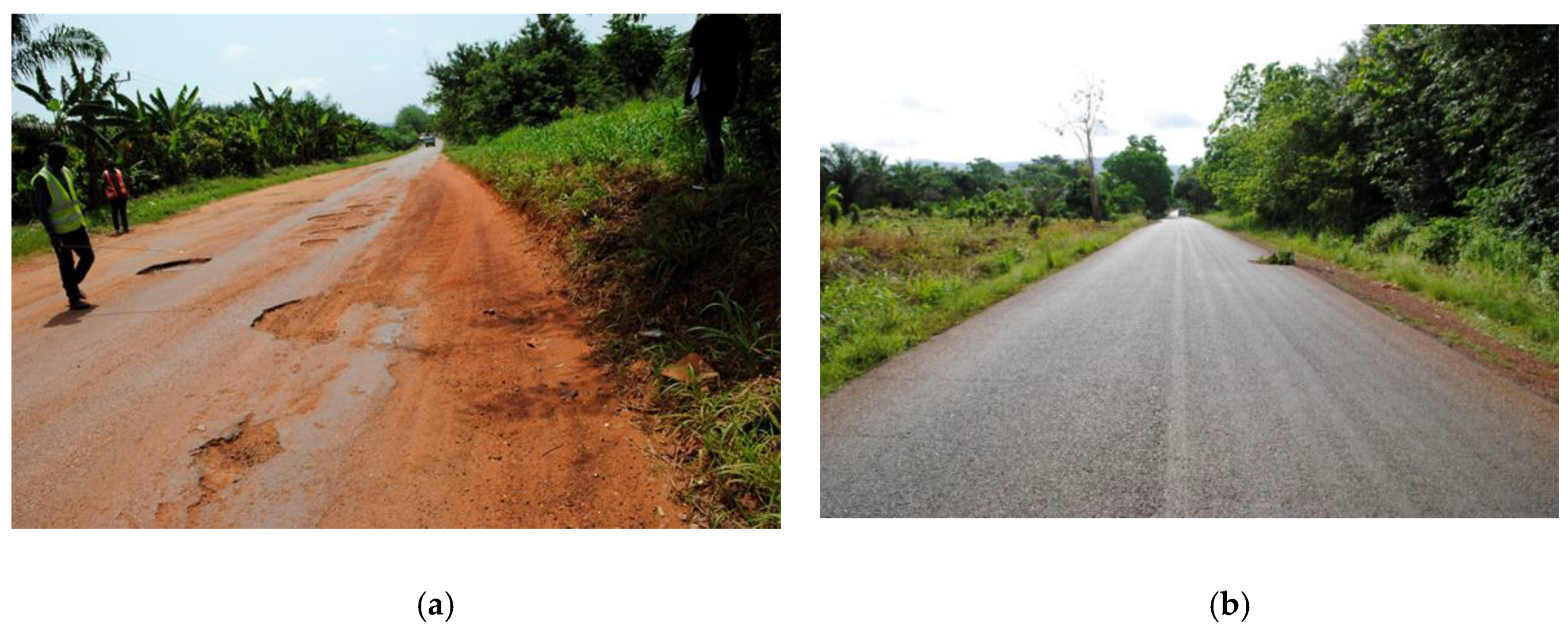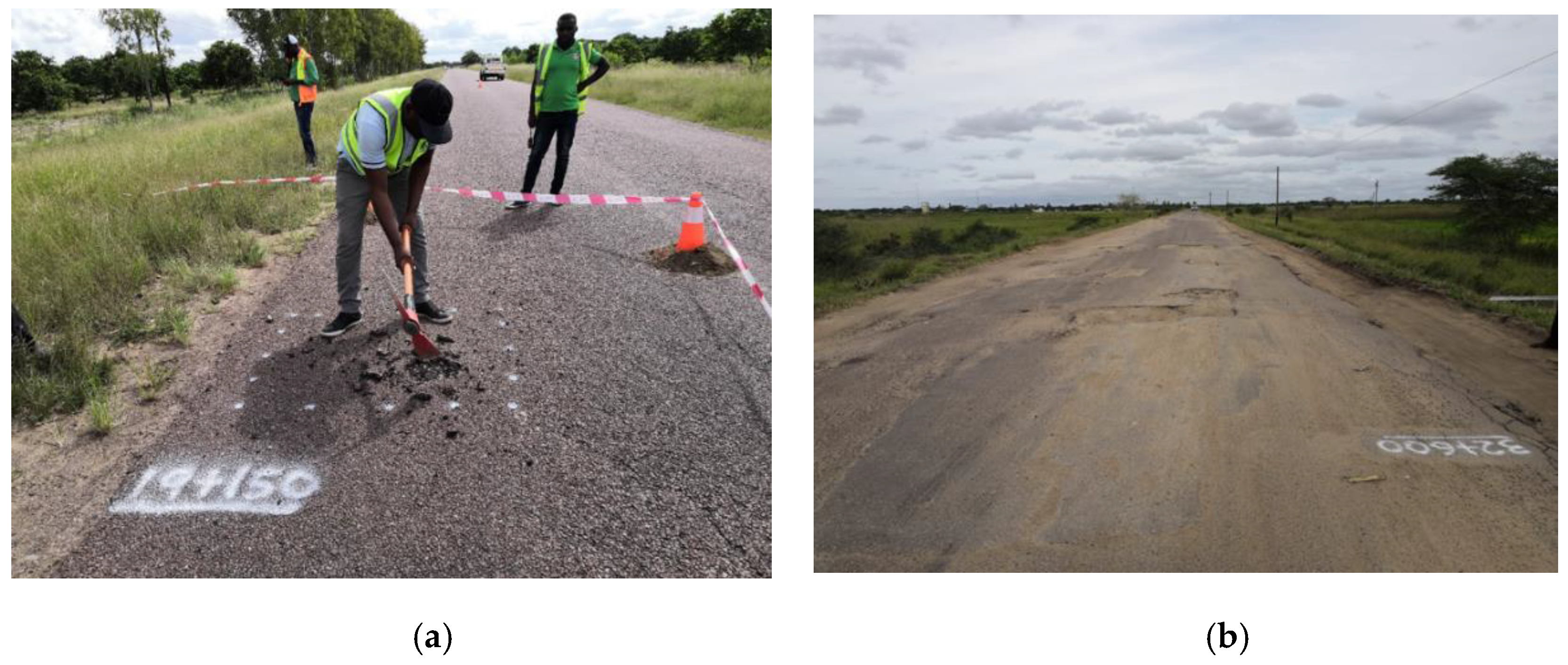The Impact of Drainage on the Performance of Low Volume Sealed Roads
Abstract
:1. Introduction
1.1. General
1.2. Background
1.3. Drainage-Related Defects
1.4. Aim and Purpose
2. Materials and Methods
- Possessed a thin bituminous surfacing/seal (not Asphalt Concrete),
- have been in existence for more than 10 years,
- preferably with bases that were constructed using locally available materials/natural gravels or lightly modified materials; but a few with coarse rock bases were also studied, and
- have a current traffic volume of more than 500 vehicles per day (vpd), based on initial traffic of 300 vpd and a growth rate of 5% for 10 years.
3. Results
3.1. General
3.2. Shoulder Type
3.2.1. Performance Classification by Shoulder Type
3.2.2. The Effect of Base Layer Characteristics on Good-Performers in Relation to Shoulder Type
3.3. Crown Height
3.3.1. Performance Classification by Crown Height
3.3.2. The Effect of Base Layer Characteristics on Good-Performers in Relation to Crown Height
3.4. Road Camber
3.5. Case Studies
3.5.1. Case Study 1: Koforidua–Adukrom
3.5.2. Case Study 2: Macia–Chokwe
4. Discussion
- Supporting the findings of previous studies, it has been shown that the use of sealed shoulders significantly improves road performance. When shoulders are sealed (see Table 4), materials of high plasticity (PI ≤ 16 and PM ≤ 560) can be used in the base layer and good performance can still be achieved. However, to achieve good performance when shoulders are unsealed, more stringent limits have to be imposed on the plasticity of the base layer (PI ≤ 10 and PM ≤ 240) in order to ensure good performance. It is also worth noting (see Table 4) that there is no significant difference in the minimum permissible strength of the base layer for roads with unsealed or sealed shoulders to ensure good performance (CBR 40–46%). This study has further shown that well-maintained grassed shoulders can also be effective in improving performance of low volume sealed roads.
- When high crown height (>0.75 m) is used, materials of high plasticity (PI ≤ 10 and PM ≤ 188) can be used in the base layer and good performance can still be achieved. However, to achieve good performance when the crown height is less than 0.5 m, more stringent limits have to be imposed on the plasticity of the base layer (PI ≤ 2 and PM ≤ 79) in order to ensure good performance (see Table 6). It is also worth noting that there is no significant difference in the minimum permissible strength (CBR 40–46%) for good performance of the base layer for the low crown height (< 0.5 m) and that for the high crown height (> 0.75 m). If the crown height is at least equal to 0.5 m, then the limits for materials characteristics for shoulder type overrides those for the crown height. Conversely, if the crown height is less than 0.5 m, then the limits for materials characteristics for the crown height overrides those for the shoulder type.
- Though Table 7 shows that good performance can be achieved even with road camber between 1% and 2%. It is safer to provide a minimum camber of 3% if natural gravels are used, especially in view of potentially more extreme events in sub-Saharan Africa, such as the climate changes. Additionally, natural gravels (commonly used in low volume roads in sub-Saharan Africa) are susceptible to rutting, which in turn can lead to rainwater ponding and ingress into the road pavement. With a high camber (3%), rainwater has a high chance of draining off.
- Adequately sized culverts that consider periodic silting capacity should be used at critical points on any low volume road (see Case Study 1).
- Capillary action has the potential to cause the failure of thin bituminous seals (see Case Study 2).
5. Conclusions
Author Contributions
Funding
Acknowledgments
Conflicts of Interest
References
- Transportation Research Board. Special Report 160. Low-Volume Roads; Transportation Research Board: Washington, DC, USA, 1975. [Google Scholar]
- Transportation Research Board. Special Report 214. Designing Safer Roads: Practices for Resurfacing, Restoration, and Rehabilitation; Transportation Research Board: Washington, DC, USA, 1987. [Google Scholar]
- American Association of State Highway and Transportation Officials (AASHTO). A Policy on the Geometric Design of Highways and Streets; AASHTO: Washington, DC, USA, 2001. [Google Scholar]
- National Cooperative Highway Research Program (NCHRP). Guide for Mechanistic-Empirical Design for New and Rehabilitated Pavement Structures: Part 4 Low volume Roads; Transportation Research Board: Washington, DC, USA, 2004. [Google Scholar]
- Ethiopian Roads Authority. Design Standards for Low Volume Roads. Ethiopian Roads Authority; ERA: Addis Ababa, Ethiopia, 2011. [Google Scholar]
- Otto, A.; Rolt, J.; Musenero, L.; Mukura, K. Development of Guidelines and Specifications for Low Volume Sealed Roads through Back Analysis, Phase 3 Final Report; ReCAP for UKaid: London, UK, 2020. [Google Scholar]
- Gourley, C.S.; Greening, P.A.K. Performance of Low Volume Sealed Roads: Results and Recommendations from Studies in Southern Africa, Volume 1, PR/OSC/167/99; TRL: Berkshire, UK, 1999. [Google Scholar]
- Rolt, J.; Gourley, C.S.; Hayes, J.P. Rational Drainage of Road Pavements PR/INT/244/02; TRL: Berkshire, UK, 2002. [Google Scholar]
- Paige-Green, P. An Alternative Philosophy on the Deterioration and Design of Low Volume Roads; CAPSA: Sun City, South Africa, 2015. [Google Scholar]
- Southern Africa Development Cooperation SADC. Guideline on Low Volume Sealed Roads; Goldfields Press (Pty) Ltd.: Johannesburg, South Africa, 2003. [Google Scholar]
- Department of Transport South Africa. TRH 22 Pavement Management Systems; DOT: Pretoria, South Africa, 1994. [Google Scholar]
- Wolff, H.; Visser, T. Review of surfacings for low-volume roads on the basis of experience in South Africa. Transp. Res. Rec. 1991, 1291, 193–201. [Google Scholar]
- Ogden, K.W. The effects of paved shoulders on accidents on rural highways. J. Accid. Anal. Prev. 1997, 29, 353–362. [Google Scholar] [CrossRef]
- Rolt, J.; Mukura, K.; Dangare, F.; Otto, A. Back Analysis of Previously Constructed Rural Roads in Mozambique; African Community Access Programme for Department for International Development: London, UK, 2013. [Google Scholar]
- Transport Research Laboratory. Overseas Road Note 6: A Guide to Geometric Design; TRL: Berkshire, UK, 1988. [Google Scholar]
- Paige-Green, P.; Verhaeghe, B.; Head, M. Climate Adaptation: Risk Management and Resilience Optimisation for Vulnerable Road Access in Africa, Engineering Adaptation Guidelines; ReCAP for UKaid: London, UK, 2019. [Google Scholar]
- Strohm, W.E.; Nettles, E.H.; Calhoun, C.C. Study of drainage characteristics of base course materials: Symposium on subsurface drainage. Highw. Res. Rec. 1967, 203, 8–28. [Google Scholar]
- Dawson, A. Water in Road Structures. Movement, Drainage & Effects; Springer: New York, NY, USA, 2008. [Google Scholar]
- Brakey, B.A. Hydrogenesis and Expansive Soils in Colorado. In Proceedings of the 6th Annual Paving Conference, University of New Mexico, Washington, DC, USA, 12–13 December 1968. [Google Scholar]
- Peck, R.B.; Hanson, W.E.; Thornburn, T.H. Foundation Engineering; Wiley: New York, NY, USA, 1974. [Google Scholar]
- Li, Y.; Zhang, C.; Chen, C.; Chen, H. Calculation of capillary rise height of soils by SWCC model. J. Adv. Civ. Eng. 2018. [Google Scholar] [CrossRef] [Green Version]




| Condition Description | Condition Index Range |
|---|---|
| Good (including very good) | 70 ≤ VCI ≤ 100 |
| Fair | 50 ≤ VCI < 70 |
| Poor (including very poor) | 0 ≤ VCI < 50 |
| Parameter | Range |
|---|---|
| Rainfall (mm/yr) | 750–2200 |
| Traffic (MESA) | 0.2–3.5 |
| Crown Height (m) | 0.1–4.0 |
| Camber (%) | 0.8–4.3 |
| Shoulder Types | Sealed, Grassed, and Unsealed |
| Base Layer Plasticity Index | 0–23 |
| Base Layer Plasticity Modulus | 0–1288 |
| Base Layer California Bearing Ratio (%) | 20–100 |
| Shoulder Type | Number of Sections | ||
|---|---|---|---|
| Visual Condition Indices | |||
| VCI < 50 Poor | 50 ≤ VCI < 70 Fair | 70 ≤ VCI ≤ 100 Good | |
| Sealed Shoulders | 4 | 5 | 18 |
| Unsealed shoulder | 6 | 4 | 11 |
| Grassed Shoulder | 0 | 2 | 9 |
| Shoulder Type | Base Layer Materials Characteristics | ||||
|---|---|---|---|---|---|
| 25th Percentile Plasticity Index | 75th Percentile Plasticity Index | 25th Percentile Plasticity Modulus | 75th Percentile Plasticity Modulus | 25th Percentile Strength (CBR %) | |
| Sealed Shoulders | 7 | 16 | 106 | 560 | 46 |
| Unsealed shoulder | 3 | 10 | 88 | 240 | 40 |
| Grassed Shoulder | 7 | 14 | 205 | 500 | 44 |
| Crown Height (m) | Numbers of Road Sections | ||
|---|---|---|---|
| Visual Condition Indices | |||
| VCI < 50 Poor | 50 ≤ VCI < 70 Fair | 70 ≤ VCI ≤ 100 Good | |
| <0.50 | 5 | 3 | 14 |
| 0.50–0.75 | 2 | 1 | 11 |
| >0.75 | 3 | 7 | 13 |
| Crown Height (m) | Base Layer Materials Characteristics | ||||
|---|---|---|---|---|---|
| 25th Percentile Plasticity Index | 75th Percentile Plasticity Index | 25th Percentile Plasticity Modulus | 75th Percentile Plasticity Modulus | 25th Percentile Strength (CBR %) | |
| CH < 0.50 | 2 | 14 | 79 | 483 | 44 |
| 0.50 ≤ CH ≤ 0.75 | 6 | 11 | 162 | 458 | 40 |
| CH > 0.75 | 10 | 15 | 188 | 522 | 46 |
| Camber (%) | Numbers of Sections | ||
|---|---|---|---|
| Visual Condition Indices | |||
| VCI < 50 Poor | 50 ≤ VCI < 70 Fair | 70 ≤ VCI ≤ 100 Good | |
| <1 | 0 | 1 | 1 |
| 1 to 2 | 1 | 3 | 13 |
| >2 | 5 | 6 | 15 |
| Section | Layer | FMC/ OMC | In situ DCP–CBR of Section (%) | Rut Depth (mm) | Crack Index (CRI) Max = 25, Min = 0 | Pothole and Patching Index (PPI) Max = 50, Min = 0 | VCI | |
|---|---|---|---|---|---|---|---|---|
| Mean | 90% ile | |||||||
| Koforidua–Adukrom 1 | Base | 1.4 | 62 | 16 | 27 | 25 | 29 | 35 |
| Sub-base | 1.2 | 63 | ||||||
| Subgrade | 0.9 | 31 | ||||||
| Koforidua–Adukrom 2 | Base | 0.8 | 91 | 6 | 12 | 12 | 2 | 78 |
| Sub-base | 1.0 | 87 | ||||||
| Subgrade | 1.4 | 21 | ||||||
| Road/Section | Crown Height (m) | Camber (%) | Shoulder Description |
|---|---|---|---|
| Koforidua–Adukrom 1 | 0.1 | 1.3 | No shoulder. Completely silted side drain. In sag and has sunken profile. |
| Koforidua–Adukrom 2 | 0.7 | 2.3 | Gravel/grassed shoulder. Grassed drain up to edge of seal. Good side drain. |
| Section | Layer | FMC/OMC | In situ DCP-CBR of Section (%) | Rut Depth (mm) | Crack Index (CRI) Max = 2, Min = 0 | Pothole and Patching Index (PPI) Max = 50, Min = 0 | VCI | |
|---|---|---|---|---|---|---|---|---|
| Mean | 90% ile | |||||||
| Macia–Chokwe 1 | Base | - | - | 6 | 11 | 9 | 7 | 75 |
| Sub-base | 0.9 | 40 | ||||||
| Subgrade | 1.6 | 50 | ||||||
| Macia–Chokwe 2 | Base | - | - | 4 | 8 | 5 | 31 | 57 |
| Sub-base | 0.7 | 96 | ||||||
| Subgrade | 2.9 | 10 | ||||||
| Road/Section | Crown Height (m) | Camber (%) | Shoulder Description |
|---|---|---|---|
| Macia–Chokwe 1 | 0.2 | 3.5 | Grassed shoulders, visible shoulder camber, no ponding, Good side drain. |
| Macia–Chokwe 2 | 1.5 | 2.5 | Gravel shoulders, occasional ponding, grass berm preventing water to side drains. Ponding on shoulder coincides with pothole on carriageway. Embankment in swamp. |
© 2020 by the authors. Licensee MDPI, Basel, Switzerland. This article is an open access article distributed under the terms and conditions of the Creative Commons Attribution (CC BY) license (http://creativecommons.org/licenses/by/4.0/).
Share and Cite
Otto, A.; Rolt, J.; Mukura, K. The Impact of Drainage on the Performance of Low Volume Sealed Roads. Sustainability 2020, 12, 6101. https://doi.org/10.3390/su12156101
Otto A, Rolt J, Mukura K. The Impact of Drainage on the Performance of Low Volume Sealed Roads. Sustainability. 2020; 12(15):6101. https://doi.org/10.3390/su12156101
Chicago/Turabian StyleOtto, Andrew, John Rolt, and Kenneth Mukura. 2020. "The Impact of Drainage on the Performance of Low Volume Sealed Roads" Sustainability 12, no. 15: 6101. https://doi.org/10.3390/su12156101
APA StyleOtto, A., Rolt, J., & Mukura, K. (2020). The Impact of Drainage on the Performance of Low Volume Sealed Roads. Sustainability, 12(15), 6101. https://doi.org/10.3390/su12156101





